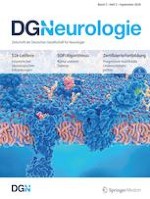12.08.2020 | Insomnie | Leitlinie
S2k-Leitlinie: Insomnie bei neurologischen Erkrankungen
Leitlinie der Deutschen Gesellschaft für Neurologie
Erschienen in: DGNeurologie | Ausgabe 5/2020
Einloggen, um Zugang zu erhaltenAuszug
-
Es gibt eine Assoziation zwischen Migräne und Kopfschmerz bei Medikamentenübergebrauch einerseits und Insomnie andererseits. Bei Spannungskopfschmerz sind die Befunde uneinheitlich.
-
Kognitiv-behaviorales Therapietraining für Insomnie (CBTi, Schlafhygiene und -restriktion) ist nach einer Pilotstudie bei chronischer und komorbider Insomnie wirksam.
-
Eszopiclon reduzierte in einer Pilotstudie [1] die nächtliche Wachzeit bei Patienten/Patientinnen mit Migräne.











